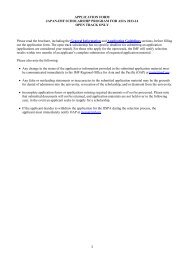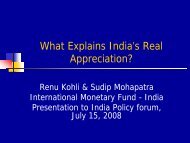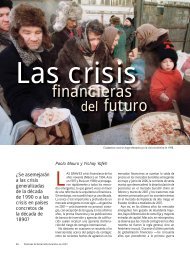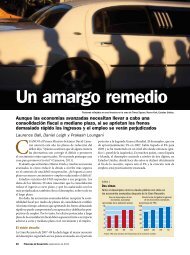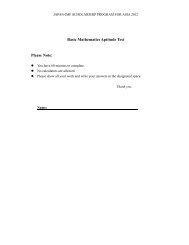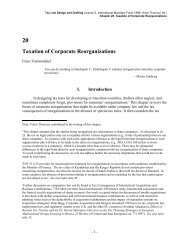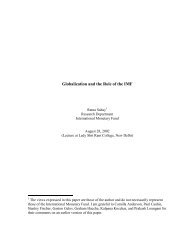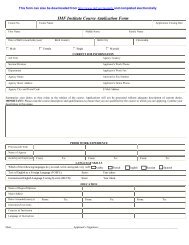Overview of Capital Account Crisis - IMF
Overview of Capital Account Crisis - IMF
Overview of Capital Account Crisis - IMF
You also want an ePaper? Increase the reach of your titles
YUMPU automatically turns print PDFs into web optimized ePapers that Google loves.
- 15 -<br />
in the aftermath its balance sheet deteriorated significantly. First, the share <strong>of</strong> domestic debt<br />
at floating rates rose as investors demanded protection against further interest rate increases<br />
(and banks sought to reduce the maturity mismatch between short-term deposits and longerterm<br />
government bonds). Second, in an effort to avoid a collapse <strong>of</strong> the banking system, the<br />
government provided a blanket guarantee for banks’ liabilities and issued bonds for their<br />
recapitalization. These bonds increased public debt by 30 percent <strong>of</strong> GDP to almost<br />
90 percent <strong>of</strong> GDP at end-2001.<br />
III. IDENTIFYING BALANCE SHEET VULNERABILITIES<br />
26. The examples above illustrate how currency and maturity mismatches in sectoral<br />
balance sheets, and linkages between them, can contribute to the likelihood that a capital<br />
account crisis could be—and ultimately was—triggered. At the same time, given emerging<br />
market countries’ limited ability to borrow in their own currencies (“original sin”), there<br />
must be FX-exposure in some sectoral balance sheet in the economy. This also means that<br />
any “hedging” will either be incomplete or that, in effect, the country is not a net recipient <strong>of</strong><br />
capital from the rest <strong>of</strong> the world. Therefore, the key to reducing vulnerability is to try to<br />
limit currency, maturity, and capital structure mismatches and ensure that risks—including to<br />
real shocks—are ultimately contained by strong balance sheets within the economy. 12<br />
27. Although balance sheet analysis is still in its infancy, the examples cited above<br />
suggest some conclusions:<br />
• The banking system <strong>of</strong>ten acts as a key transmission channel <strong>of</strong> balance sheet problems<br />
from one sector into another. If a shock in the corporate sector (Asian crisis countries) or<br />
the public sector (Russia 1998, Turkey 2001, Argentina 2002) results in it being unable to<br />
meet its liabilities, then another sector—typically the banking sector—loses its claims. In<br />
turn, this can cause a deposit run, sparking a banking crisis, especially if the<br />
government’s own balance sheet is too weak to provide credible deposit insurance or<br />
lacks international reserves to provide liquidity support in foreign exchange. By the same<br />
token, if banks tighten their lending to prevent their portfolios from deteriorating, then<br />
this further complicates the situation <strong>of</strong> the corporate or public sector that is facing<br />
financing difficulties.<br />
• If the government’s balance sheet is sufficiently strong, it can serve as a “circuit<br />
breaker,” halting the propagation <strong>of</strong> shocks across domestic balance sheets. In a number<br />
<strong>of</strong> recent crises (e.g., Argentina 2002), however, the government balance sheet was the<br />
12 To use an analogy, lightning strikes might leave a house at risk <strong>of</strong> burning down and while<br />
measures can be taken to reduce that risk (e.g., installing a lightning conductor), some risk<br />
may be unavoidable. By purchasing insurance, however, the homeowner transfers the<br />
associated financial risk from his own relatively weak, undiversified balanced sheet to that <strong>of</strong><br />
the insurance company, which is much stronger in that it holds diversified risks.





